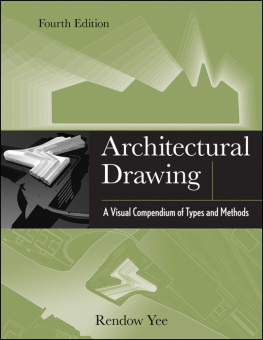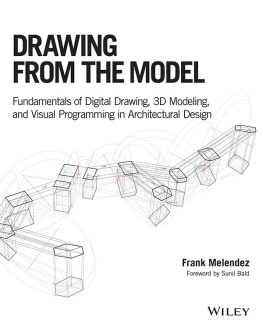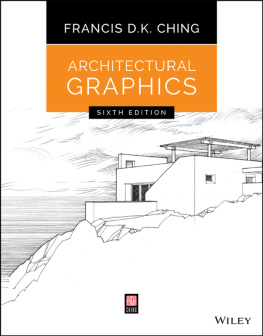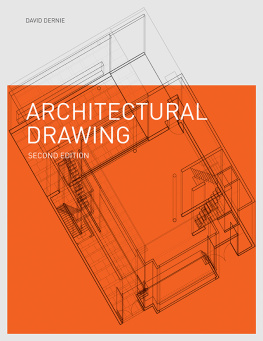ARCHITECTURAL DRAWING
Copyright 2013 by John Wiley & Sons, Inc. All rights reserved
Published by John Wiley & Sons, Inc., Hoboken, New Jersey
Published simultaneously in Canada
No part of this publication may be reproduced, stored in a retrieval system, or transmitted in any form or by any means, electronic, mechanical, photocopying, recording, scanning, or otherwise, except as permitted under Section 107 or 108 of the 1976 United States Copyright Act, without either the prior written permission of the Publisher, or authorization through payment of the appropriate per-copy fee to the Copyright Clearance Center, 222 Rosewood Drive, Danvers, MA 01923, (978) 750-8400, fax (978) 646-8600, or on the web at www.copyright.com . Requests to the Publisher for permission should be addressed to the Permissions Department, John Wiley & Sons, Inc., 111 River Street, Hoboken, NJ 07030, (201) 748-6011, fax (201) 748-6008, or online at www.wiley.com/go/permissions .
Limit of Liability/Disclaimer of Warranty: While the publisher and the author have used their best efforts in preparing this book, they make no representations or warranties with respect to the accuracy or completeness of the contents of this book and specifically disclaim any implied warranties of merchantability or fitness for a particular purpose. No warranty may be created or extended by sales representatives or written sales materials. The advice and strategies contained herein may not be suitable for your situation. You should consult with a professional where appropriate. Neither the publisher nor the author shall be liable for any loss of profit or any other commercial damages, including but not limited to special, incidental, consequential, or other damages.
For general information about our other products and services, please contact our Customer Care Department within the United States at (800) 762-2974, outside the United States at (317) 572-3993 or fax (317) 572-4002.
Wiley publishes in a variety of print and electronic formats and by print-on-demand. Some material included with standard print versions of this book may not be included in e-books or in print-on-demand. If this book refers to media such as a CD or DVD that is not included in the version you purchased, you may download this material at http://booksupport.wiley.com . For more information about Wiley products, visit www.wiley.com .
Library of Congress Cataloging-in-Publication Data:
Yee, Rendow.
Architectural drawing : a visual compendium of types and methods / Rendow Yee. Fourth edition.
pages cm
Includes bibliographical references and index.
ISBN 978-1-118-01287-1 (paper/ws); 978-1-118-31040-3 (ebk); 978-1-118-31041-0 (ebk); 978-1-118-31044-1 (ebk); 978-1-118-29994-4 (ebk); 978-1-118-29995-1 (ebk)
1. Architectural drawingTechnique. I. Title.
NA2708.Y439 2012
720.284dc23
2011049849
Dedicated to each student studying this book
past and present
Always a source of insightful and innovative ideas.
To my parents
Always a source for inspiration.
Preface to the Fourth Edition
The fourth edition adds two important chapters, Introduction to the Digital/Manual Interface and Introduction to Portfolio Building. The first new chapter is critical for a students understanding of how manual drawing and digital modeling play off of each other as partners in design thinking. This partnership is increasingly important, as the simultaneous use of both modes seems to be the most efficacious approach to design drawing. The second new chapter addresses the need for students to formulate portfolios for their work and future careers.
I am deeply grateful for the superlative work of the contributing author for the digital/manual chapter, Professor William W. P. Chan of Morgan State Universitys architecture department. He also worked with me as a consultant, shedding light on many other issues in the book. I would also like to express my deep gratitude for the three reviews I received for the portfolio chapter from Professor Mark A. Pearson of the College of DuPage, Professor Hiro Hata of SUNY at Buffalo, and Professor Chan. Special appreciation goes to Guobin Yu, who assisted with the transferring of countless images to CDs. A special thanks to Wiley assistant editor Lauren Poplawski and editorial assistant Danielle Giordano, both of whom patiently worked with me on numerous issues and problems. Finally, I would like to acknowledge the outstanding student projects submitted for inclusion in the book by the schools listed below.
Acknowledgments
Professor William W. P. Chan, Morgan State University (Maryland)
Professor Paul Chiu, Glendale Community College (California)
Professor Paul Walker Clarke, Morgan State University (Maryland)
Professor Kim de Freitas, New Jersey Institute of Technology
Professor Michael D. Hagge, University of Memphis
Professor Bob Hansman, Washington University in St. Louis (Missouri)
Professor Hiro Hata, State University of New York at Buffalo
Professor Weiling He, Texas A&M University
Professor Meg Jackson, Texas A&M University
Professor Julie Ju-Youn Kim, The Catholic University of America (Washington, DC)
Professor Andreas Luescher, Bowling Green State University (Ohio)
Professor Lauren Karwoski Magee, Drexel University (Pennsylvania)
Professor Jane Ostergaard, College of DuPage (Illinois)
Professor Mark A. Pearson, College of DuPage (Illinois)
Professor Julia S. Rogers, Texas A&M University
Professor Stephen Temple, University of Texas at San Antonio
Professor Marissa Tirone, Syracuse University (New York)
Professor Jon Thompson, University of Texas at San Antonio
Dr. M. Saleh Uddin, Southern Polytechnic University (Georgia)
Preface to the Third Edition
The third edition introduces hierarchy to make the book easier to use and its information more accessible. The hierarchical table of contents, for example, allows readers to reference the most salient topics quickly. Structural hierarchy within each chapter is based on two stages: BASICS and BASICS APPLIED. BASICS incorporates fundamental elements such as theory, definitions, principles, and concepts. BASICS APPLIED provides step-by-step how-to applications, along with student and professional examples.
The third edition has also expanded the content in the companion website. In addition to the initial second-edition website chapter titled Conventional and Computerized Representation in Color, two new chaptersand an appendixhave been added. The chapters are titled Interfacing Manual with Digital: Professional Office Example and Interfacing Manual with Digital: Academic Studio Examples. The interfacing chapters show projects that integrate manual with digital methods. The appendix offers a brief review of geometric definitions and some important principles of descriptive geometry.
I would especially like to thank Professor William Chan of Morgan State University, who was so gracious in donating his time to review most of the chapters as well as the companion website in the second edition. I also appreciate the comments on specific pages by Professors Dick Davison of Texas A&M and Arpad Daniel Ronaszegi of the Savannah College of Art and Design. Finally, I would like to acknowledge the assistance of Tina Chau, Chalina Chen, and Susan Wu.
Acknowledgments
Professor William W. P. Chan, Morgan State University (Baltimore, Maryland)











